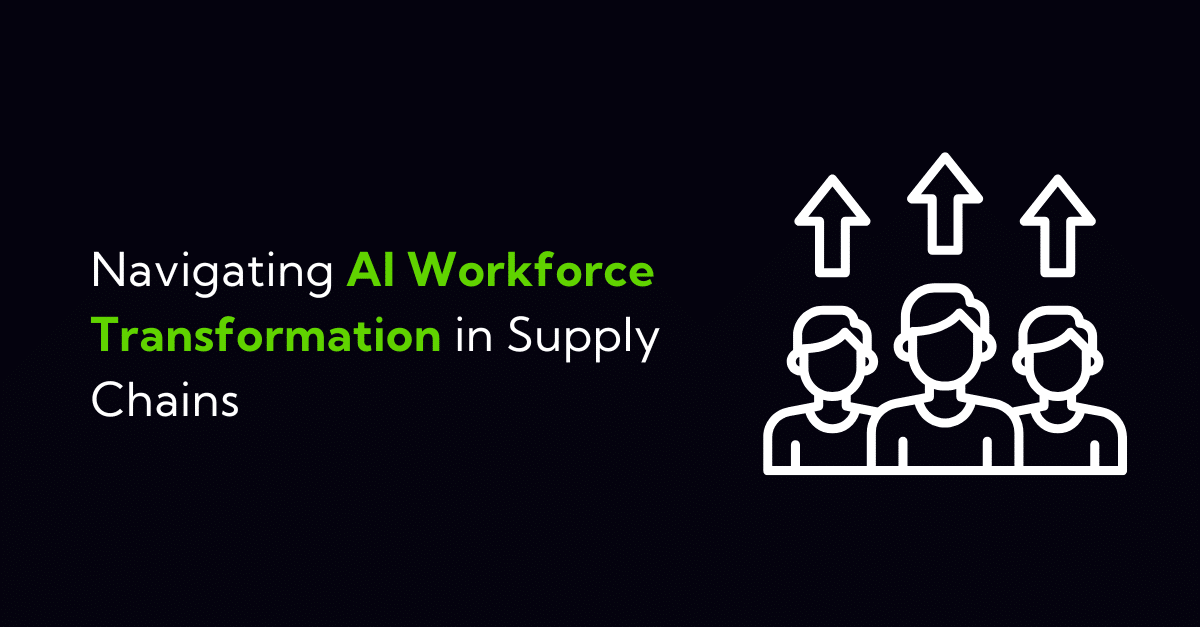
AI and supply chain experts discuss AI use cases transforming supply chain planning and how human-in-the-loop strategies drive operational efficiency and AI adoption.
Endless news and noise about the transformative potential of artificial intelligence have made it difficult for business leaders to distinguish AI hype from reality. As supply chain leaders explore AI to make informed decisions, they have new questions about what is truly real, practical, and applicable in today’s environment.
Logility’s Dehyped Series is a virtual thought leadership series for supply chain leaders who want to look beyond the buzz to the substance about what AI can do for supply chains today and in the next five years.
The inaugural session brought together three experts with decades of experience in supply chain management and AI to explore what leading organizations are doing with AI, how planning is evolving, and to examine the emerging concept of a decision-centric enterprise.
The AI Landscape and Its Evolution in Supply Chain Planning
Despite its rapid rise to prominence in recent years, AI remains misunderstood by many. While machine learning and AI have been around for decades, the growth of transformer technology, such as Generative Pre-training Transformer (GPT), in 2023 has reduced barriers to adoption. “The development of GPTs has made AI practical, cost-effective, and accessible without the need for a large-scale, specialized data science team,” said Scott Tillman, SVP of Agile Practice and Process Improvement at Logility.
Microsoft is conducting ongoing research that has identified more than 1,100 AI use cases, ranging from control plane applications, such as automation, chatbots, and dashboards, to data plane functions, including machine learning and cognitive analysis. Eduardo Kassner, CTO of Cloud & AI for the High-Tech Sector at Microsoft, notes that AI is now being used in many areas, including visual, audio, sentiment analysis, cognitive search, and translation. The wide-ranging variety of applications has fueled an unprecedented “spring of development” that is accelerating adaptive applications that learn and continually improve through interaction and correction. Kassner compares the current AI explosion to an “App Store movement,” where developers and businesses can now use the infrastructure to offer new use cases with intelligent applications and substantial value to users.
“All of a sudden, we don’t just have one tool that’s easier to use, better, cheaper, and faster. We now have a bunch of applications across the myriad of AI,” Kassner said.
When asked where participants of DeHyped were in their AI journey, approximately half (52%) reported that they were starting to explore. Nearly a quarter (24%) reported scaling adoption in some areas, while 20% stated they were running pilots or proofs of concept.
However, Tillman notes companies don’t have to “boil the ocean” to start with AI. Instead, they can start small with use-driven cases based on a small subject of data, vendor, application, or process, and then learn and refine as they go. “You don’t have to figure everything out up front before you build it,” Tillman said. “If you are waiting for a perfect model to see what your AI is going to look like, you are going to be left behind.”
Transforming Planning and Decision-Making with Human-in-the-Loop AI
Piet Buyck, SVP, Industry Principal at Logility, notes AI is having a transformative impact on supply chain planning by moving it from static, number-driven processes to dynamic, insight-driven, decision-centric practices that can be integrated across all levels of the organization.
Traditional planning typically involves aggregating numbers from multiple divisions, which requires discussions and reconciling assumptions that account for bias and uncertainty. However, AI can break down these barriers by linking numbers with underlying data sources and continuously syncing the insights. Large language models are also making complex supply chain systems accessible to frontline workers with natural language and by democratizing expertise that was traditionally limited to specialists.
“Instead of people having to align, they can go right to the source to know what impacts that number,” said Buyck. “Because that information is digital and in a [clear language], everything typically hidden behind that number is available to all parts of the organization for insights.”
While organizations have long utilized data and dashboards, they haven’t always leveraged them to inform decisions. AI can quickly and easily make data more actionable, allowing supply chain planners to utilize it to make optimal decisions instantly. “And that’s where AI agents can really help. They can mine that data for decisions and actions and make it more of a decision-centric paradigm where decisions drive the process, not just the data,” Tilliman said.
However, adopting AI capabilities comes with many considerations around accuracy, trust, compliance, and data sovereignty. When attendees were polled on the biggest obstacles in moving from static to data-driven planning, 43% said the biggest issues were trust in the data and insights. Meanwhile, 21% said the greatest obstacle was the adoption of change management or a lack of skills and experience.
As a result, organizations are advised to start small with clear use cases, then gradually build confidence and demonstrate value in their AI applications. One way to achieve this is to employ agile, use-case-driven development supported by rapid prototyping tools that offer quick validation and can be iteratively refined. Additionally, by designing frameworks that keep humans in the loop, organizations can validate data, reasoning, and outcomes. This enables them to offer continues feedback to the system, which increases trust and accuracy in the outputs. The best and most well-adopted AI applications are those that are partially automated and have human attestation to ensure accuracy and trust, Kassner said.
“Humans still like humans, and we need someone to attest for compliance and value reasons and to [identify] hallucinations,” Kassner said. “This will be collaborative for a while. With humans in the loop, there is wider adoption and more guardrails for when something goes wrong.”
Cultivating an Innovative, Learning-Driven AI Culture
To tap the full potential of AI, supply chain organizations will need to make cultural shifts, increase employee skills, and take practical action steps. Executives and managers will need to build personal experience with hands-on experimentation to move beyond the assumptions and skepticism about AI limits. Kassner notes that by adopting a learning-focused mindset that emphasizes iterative growth, planners can look beyond the idea of failures as losses. For example, he notes that SpaceX’s successful vertical rocket landings resulted from years of trial and error, as well as continuous experimentation and evolution.
“They just learned by trying and failing for 12 years. With AI, you will have to do a lot of experiments. The culture has to be one of learning with microexperiments, trials, and learning, you continue to evolve your thinking, and everything can help you be a little better,” Kassner said.
Buyck notes these modern AI tools now enable supply chain leaders to use rapid prototyping, making applications feasible in hours instead of the traditional months-long cycle with rigorous planning and operational scale implementations. He highlights the premises of decision-centric planning in supply chain in his book The AI Compass for Supply Chain Leaders. Decision-centric planning shifts the focus from defending forecast numbers to optimizing outcomes. Rather than operating on calendar-based cycles that chase old demand, supply chain leaders can use AI to synchronize decisions with real-world events as they happen. It uses multiple streams of information to make information available to all stakeholders in a shared language.
Tillman said that making the most of AI ultimately entails looking beyond AI as a simple tool and seeing it more as a partner. “There needs to be a cultural readiness in your organization. You can’t just look at AI as a tool. It has to be a collaborator and something you are willing to partner with and that can require an organizational mindset change,” Tillman said.
Conclusion
AI has the potential to drive revolutionary improvements in supply chain planning, particularly when used to support a decision-centric framework. However, attaining tangible benefits calls for experimentation, building trust, and integrating human collaboration. Originations will also need to evolve their organizational culture and skills to partner with AI effectively. Doing so will offer leaders both the strategic perspective and practical guidelines to confidently navigate AI adoption pathways
Frequently Asked Questions
Where does Human Intelligence (HI) fit in with AI?
AI is a collaborator, not a replacement. Human oversight is essential for contextual judgment, trust and validation, and ethical decision-making.
How would AI handle major disruptions like the Suez Canal blockage?
AI can’t prevent disruptions, but it can simulate scenarios, identify alternative suppliers or routes, and respond faster with data-driven agility. This leads to more resilient supply chains.
How can AI drive value across the supply chain?
AI enables smarter demand forecasting, faster scenario planning, real-time risk detection and Decision automation. The value lies in speed, precision, and adaptability.
Why is AI adoption more common in execution than planning?
Execution systems are more structured and transactional. Planning involves strategic thinking and cross-functional data, which is harder to model. However, LLMs and GenAI are now enabling planning systems to catch up.



